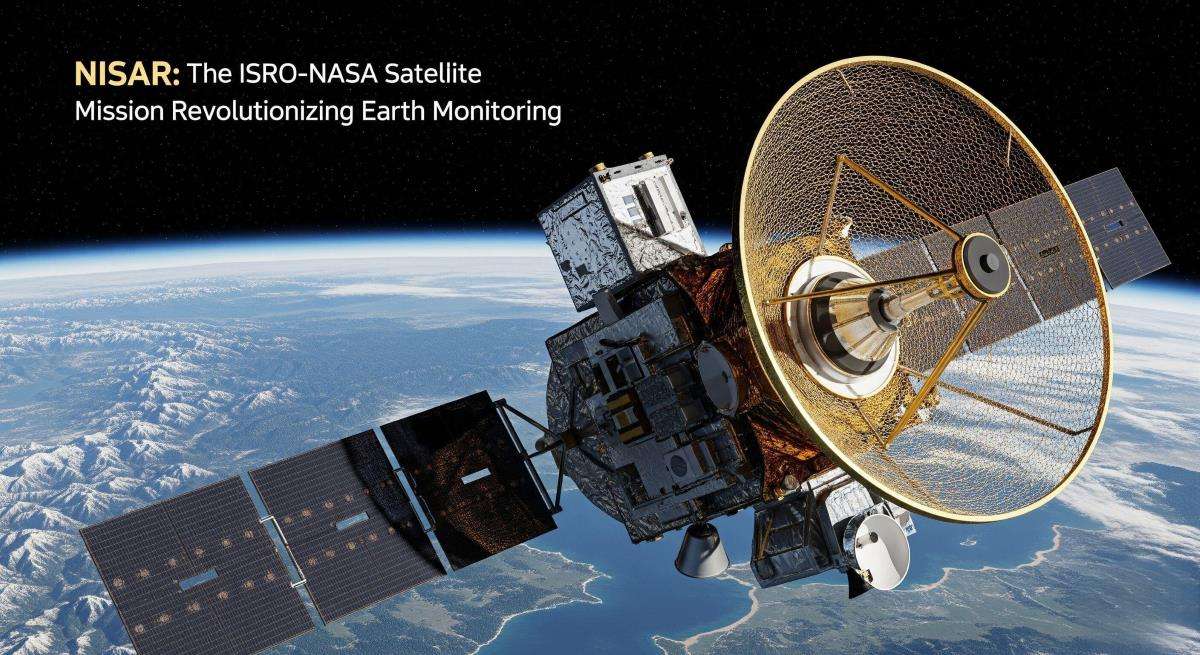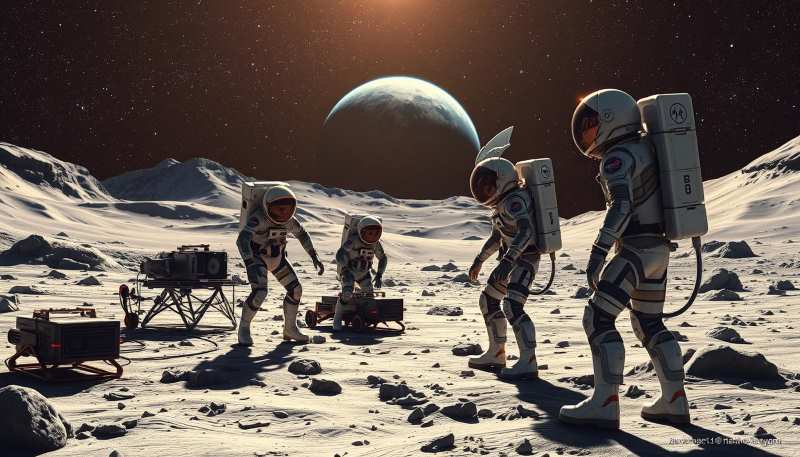India and the U.S. launch the most advanced Earth-observation satellite ever built, opening new frontiers in disaster management, climate science, and global space collaboration.
Watching the Earth to Save It By NISAR
When the Earth shifts, cracks, or floods, lives are at stake. What if we could see those changes in real-time—before they become disasters? That’s the promise of NISAR, a historic satellite collaboration between NASA and ISRO (Indian Space Research Organisation).

credit: wikipidia.org
Launched on July 30, 2025, from India’s Satish Dhawan Space Centre, NISAR (NASA-ISRO Synthetic Aperture Radar) marks the first time the world’s top two space agencies have jointly developed an Earth-observation satellite. The mission is not just a technical marvel—it’s a turning point in disaster preparedness, climate monitoring, and international space diplomacy.
Table of Contents
What Is NISAR?
NISAR is a radar imaging satellite that uses dual-frequency Synthetic Aperture Radar (SAR) to measure subtle changes in Earth’s surface. This includes landslides, earthquakes, glacier movement, coastal erosion, and crop health.
“NISAR is designed to see the invisible—millimeter-scale changes from space that impact life on Earth.” — NASA JPL
NISAR’s uniqueness lies in its dual-band radar technology:
- L-band radar (provided by NASA): Penetrates deeper into forests, ice, and soil
- S-band radar (developed by ISRO): Offers high-resolution imaging of surface structures
This combination allows for all-weather, day-and-night Earth observation, a gamechanger in both science and emergency response.
Why NISAR Matters: Key Use Cases
1. Disaster Prediction and Management
India’s Minister of Science and Technology, Dr. Jitendra Singh, told Lok Sabha that NISAR will be a “gamechanger” in disaster monitoring and response. The satellite will be able to detect shifts in Earth’s surface before major earthquakes or landslides happen—offering precious time for warnings and evacuation.
Benefits:
- Predict land subsidence and tectonic shifts
- Monitor flood zones, coastal erosion, and glacial lake outbursts
- Aid rapid post-disaster damage assessment
“Millimeter-level data today can save thousands of lives tomorrow.”
2. Climate Change and Environmental Monitoring
NISAR will play a major role in tracking melting glaciers, carbon stocks in forests, and changes in wetland ecosystems. This data is essential for climate models, carbon trading, and environmental policymaking.
- Monitor ice sheets in Antarctica and Himalayas
- Track deforestation and forest degradation
- Study soil moisture and vegetation growth
“You can’t fight climate change blind. NISAR brings clarity.”
3. Agriculture and Water Resource Management
In agriculture, early warnings on soil health, drought stress, and crop biomass are vital. NISAR’s radar sensors will deliver such data to farmers, agricultural scientists, and governments—leading to precision farming, efficient irrigation, and food security planning.
- Enhance seasonal yield predictions
- Track irrigation impact on groundwater
- Optimize fertilizer use and planting cycles
4. Urban Planning and Infrastructure Safety
NISAR will support smarter cities and safer infrastructure by detecting ground deformation near highways, railways, and dams. In high-density areas, it can warn of foundation instability and sinkholes before they cause real damage.
Technology at a Glance
| Feature | Capability |
|---|---|
| Orbit | 743 km Sun-synchronous orbit |
| Repeat Frequency | Every 12 days |
| Resolution | Can detect changes as small as a few millimeters |
| Coverage | Global; nearly all landmass |
| Data Accessibility | Open-source and free for global users |
“It’s like Google Earth—on steroids, in real time, and for science.”
The Power of Collaboration: NASA + ISRO
The NISAR satellite is a symbol of scientific unity in a divided world. Built over a decade through tight collaboration, the project brings together:
- NASA’s Jet Propulsion Laboratory (JPL): Delivered the L-band radar, avionics, and launch support
- ISRO: Built the satellite structure, S-band radar, and provided the GSLV Mk II launch system
The satellite was airlifted from California to Bengaluru in 2024, underwent extensive thermal testing, and was integrated at UR Rao Satellite Centre (URSC) in Bengaluru.
This mission continues the growing Indo-US space partnership, echoing previous collaborations like Chandrayaan‑1 (2008) and Earth System Science cooperation between NOAA and ISRO.
👉 Hyper excited mission about Collaboration of Jaxa and ISRO
Why This Matters Globally
NISAR is not just for India or the U.S.—it’s for the world. Its open data policy ensures that every nation, researcher, and responder can benefit from its insights.
Potential Global Impact:
- UN agencies for climate tracking
- NGOs working in disaster relief
- Local governments planning coastal defenses
- Startups building AI models for environmental risk
“A satellite that belongs to science. And to everyone.”
Open Access, Open Innovation
NASA and ISRO have committed to releasing NISAR’s datasets to the public within days of acquisition. This transparency is designed to spark innovation in climate tech, disaster AI, smart farming, and sustainability apps.
Expect breakthroughs in:
- Academic research
- Climate-focused startups
- NGO disaster modeling tools
- Environmental journalism and advocacy
Strategic Benefits for India
India gains not only data but also deep experience in handling complex radar technologies, global trust, and a seat at the high table of global space science.
As Minister Jitendra Singh noted in Parliament, the mission showcases India’s role as a “Vishwa Bandhu”—a global friend contributing to collective resilience and scientific progress.
It also positions India’s growing space economy—estimated to reach $44 billion by 2033—as a hub for space-tech startups, remote sensing solutions, and Earth observation services.
Final Thoughts: One Mission, Many Futures
NISAR is more than hardware in orbit. It’s a vision of a planet managed by knowledge, not by reaction. A radar satellite that listens to the Earth’s heartbeat, warning us before it skips.





